Psychology Classics On Amazon

Forming Impressions of Personality
Forming Impressions of Personality by Solomon Asch is a classic study in the psychology of interpersonal perception. The central tenet of this research is that particular information we have about a person, namely the traits we believe they possess, is the most important factor in establishing our overall impression of that person.
This is the journal article which introduced the concept of central versus peripheral traits and the "halo effect".

The Article in Full
We look at a person and immediately a certain impression of his character forms itself in us. A glance, a few spoken words are sufficient to tell us a story about a highly complex matter. We know that such impressions form with remarkable rapidity and with great ease. Subsequent observation may enrich or upset our first view, but we can no more prevent its rapid growth than we can avoid perceiving a given visual object or hearing a melody. We also know that this process, though often imperfect, is also at times extraordinarily sensitive.
This remarkable capacity we possess to understand something of the character of another person, to form a conception of him as a human being, as a center of life and striving, with particular characteristics forming a distinct individuality, is a precondition of social life. In what manner are these impressions established? Are there lawful principles regulating their formation?
One particular problem commands our attention. Each person confronts us with a large number of diverse characteristics. This man is courageous, intelligent, with a ready sense of humor, quick in his movements, but he is also serious, energetic, patient under stress, not to mention his politeness and punctuality. These characteristics and many others enter into the formation of our view. Yet our impression is from the start unified; it is the impression of one person. We ask: How do the several characteristics function together to produce an impression of one person? What principles regulate this process?
|
We have mentioned earlier that the impression of a person grows quickly and easily. Yet our minds falter when we face the far simpler task of mastering a series of disconnected numbers or words. We have apparently no need to commit to memory by repeated drill the various characteristics we observe in a person, nor do some of his traits exert an observable retroactive inhibition upon our grasp of the others. Indeed, they seem to support each other. And it is quite hard to forget our view of a person once it has formed. Similarly, we do not easily confuse the half of one person with the half of another. It should be of interest to the psychologist that the far more complex task of grasping the nature of a person is so much less difficult. |
|
There are a number of theoretical possibilities for describing the process of forming an impression, of which the major ones are the following:
1. A trait is realized in its particular quality. The next trait is similarly realized, etc. Each trait produces its particular impression. The total impression of the person is the sum of the several independent impressions. If a person possesses traits a, b, c, d, e, then the impression of him may be expressed as:
I. Impression = a + b + c + d + e
Few if any psychologists would at the present time apply this formulation strictly. It would, however, be an error to deny its importance for the present problem. That it controls in considerable degree many of the procedures for arriving at a scientific, objective view of a person (e.g., by means of questionnaires, rating scales) is evident. But more pertinent to our present discussion is the modified form in which Proposition I is applied to the actual forming of an impression. Some psychologists assume, in addition to the factors of Proposition I, the operation of a "general impression." The latter is conceived as an affective force possessing a plus or minus direction which shifts the evaluation of the several traits in its direction. We may represent this process as follows:
Ia. Impression =

To the sum of the traits there is now added another factor, the general impression.
2. The second view asserts that we form an impression of the entire person. We see a person as consisting not of these and those independent traits (or of the sum of mutually modified traits), but we try to get at the root of the personality. This would involve that the traits are perceived in relation to each other, in their proper place within the given personality. We may express the final impression as
II. Impression =
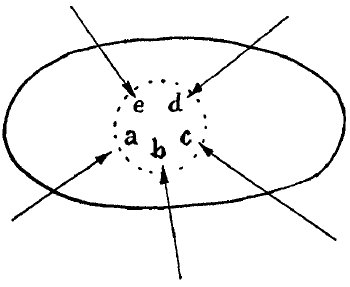
It may appear that psychologists generally hold to some form of the latter formulation. The frequent reference to the unity of the person, or to his "integration," implying that these qualities are also present in the impression, point in this direction. The generality of these expressions is, however, not suitable to exact treatment. Terms such as unity of the person, while pointing to a problem, do not solve it. If we wish to become clear about the unity in persons, or in the impression of persons, we must ask in what sense there is such unity, and in what manner we come to observe it. Secondly, these terms are often applied interchangeably to Propositions II and Ia. It is therefore important to state at this point a distinction between them.
For Proposition II, the general impression is not a factor added to the particular traits, but rather the perception of a particular form of relation between the traits, a conception which is wholly missing in Ia. Further, Proposition Ia conceives the process in terms of an imposed affective shift in the evaluation of separate traits, whereas Proposition II deals in the first instance with processes between the traits each of which has a cognitive content. Perhaps the central difference between the two propositions becomes clearest when the accuracy of the impression becomes an issue. It is implicit in Proposition II that the process it describes is for the subject a necessary one if he is to focus on a person with maximum clarity. On the other hand, Proposition Ia permits a radically different interpretation. It has been asserted that the general impression "colors" the particular characteristics, the effect being to blur the clarity with which the latter are perceived. In consequence the conclusion is drawn that the general impression is a source of error which should be supplanted by the attitude of judging each trait in isolation, as described in Proposition I. This is the doctrine of the "halo effect" (9).
With the latter remarks, which we introduced only for purposes of illustration, we have passed beyond the scope of the present report. It must be made clear that we shall here deal with certain processes involved in the forming of an impression, a problem logically distinct from the actual relation of traits' within a person. To be sure, the manner in which an impression is formed contains, as we shall see, definite assumptions concerning the structure of personal traits. The validity of such assumptions must, however, be established in independent investigation.
The issues we shall consider have been largely neglected in investigation. Perhaps the main reason has been a one-sided stress on the subjectivity of personal judgments. The preoccupation with emotional factors and distortions of judgment has had two main consequences for the course investigation has taken. First, it has induced a certain lack of perspective which has diverted interest from the study of those processes which do not involve subjective distortions as the most decisive factor. Secondly, there has been a tendency to neglect the fact that emotions too have a cognitive side, that something must be perceived and discriminated in order that it may be loved or hated. On the other hand, the approach of the more careful studies in this region has centered mainly on questions of validity in the final product of judgment. Neither of the main approaches has dealt explicitly with the process of forming an impression. Yet no argument should be needed to support the statement that our view of a person necessarily involves a certain orientation to, and ordering of, objectively given, observable characteristics. It is this aspect of the problem that we propose to study.
Forming a Unified Impression: Procedure
The plan followed in the experiments to be reported was to read to the subject a number of discrete characteristics, said to belong to a person, with the instruction to describe the impression he formed. The subjects were all college students, most of whom were women. They were mostly beginners in psychology. Though they expressed genuine interest in the tasks, the subjects were not aware of the nature of the problem until it was explained to them. We illustrate our procedure with one concrete instance. The following list of terms was read:
energetic — assured — talkative — cold — ironical — inquisitive — persuasive.
The reading of the list was preceded by the following instructions:
I shall read to you a number of characteristics that belong to a particular person.
Please listen to them carefully and try to form an impression of the kind of person described. You will later be asked to give a brief characterization of the person in just a few sentences. I will read the list slowly and will repeat it once.
The list was read with an interval of approximately five seconds between the terms. When the first reading was completed, the experimenter said, "I will now read the list again," and proceeded to do so. We reproduce below a few typical sketches written by subjects after they heard read the list of terms:
He seems to be the kind of person who would make a great impression upon others at a first meeting. However as time went by, his acquaintances would easily come to see through the mask. Underneath would be revealed his arrogance and selfishness.
He is the type of person you meet all too often: sure of himself, talks too much, always trying to bring you around to his way of thinking, and with not much feeling for the other fellow.
He impresses people as being more capable than he really is. He is popular and never ill at ease. Easily becomes the center of attraction at any gathering. He is likely to be a jack-of-all-trades. Although his interests are varied, he is not necessarily well-versed in any of them. He possesses a sense of humor. His presence stimulates enthusiasm and very often he does arrive at a position of importance.
Possibly he does not have any deep feeling. He would tend to be an opportunist. Likely to succeed in things he intends to do. He has perhaps married a wife who would help him in his purpose. He tends to be skeptical.
The following preliminary points are to be noted: 1. When a task of this kind is given, a normal adult is capable of responding to the instruction by forming a unified impression. Though he hears a sequence of discrete terms, his resulting impression is not discrete. In some manner he shapes the separate qualities into a single, consistent view. All subjects in the following experiments, of whom there were over 1,000, fulfilled the task in the manner described. No one proceeded by reproducing the given list of terms, as one would in a rote memory experiment; nor did any of the subjects reply merely with synonyms of the given terms.
2. The characteristics seem to reach out beyond the merely given terms of the description. Starting from the bare terms, the final account is completed and rounded. Reference is made to characters and situations which are apparently not directly mentioned in the list, but which are inferred from it.
3. The accounts of the subjects diverge from each other in important respects. This will not be surprising in view of the variable content of the terms employed, which permits a considerable freedom in interpretation and weighting.
In the experiments to be reported the subjects were given a group of traits on the basis of which they formed an impression. In view of the fact that we possess no principles in this region to help in their systematic construction, it was necessary to invent groupings of traits. In this we were guided by an informal sense of what traits were consistent with each other.
The procedure here employed is clearly different from the everyday situation in which we follow the concrete actions of an actual person. We have chosen to work with weak, incipient impressions, based on abbreviated descriptions of personal qualities. Nevertheless, this procedure has some merit for purposes of investigation, especially in observing the change of impressions, and is, we hope to show, relevant to more natural judgment.
More detailed features of the procedure will be described subsequently in connection with the actual experiments. We shall now inquire into some of the factors that determine the content and alteration of such impressions.

1. CENTRAL AND PERIPHERAL CHARACTERISTICS
A. Variation of a Central Quality
Observation suggests that not all qualities have the same weight in establishing the view of a person. Some are felt to be basic, others secondary. In the following experiments we sought for a demonstration of this process in the course of the formation of an impression.
Experiment 1.
Two groups, A and B, heard read a list of character-qualities, identical save for one term. The list follows:
A. intelligent—skillful—industrious—warm—determined—practical—cautious
B. intelligent—skillful—industrious—cold—determined—practical—cautious
Group A heard the person described as "warm"; Group B, as "cold."
Technique
The instructions were as described above. Following the reading, each subject wrote a brief sketch. The sketches furnish concrete evidence of the impressions formed. Their exact analysis involves, however, serious technical difficulties. It seemed, therefore, desirable to add a somewhat simpler procedure for the determination of the content of the impression and for the purpose of group comparisons. To this end we constructed a check list sense of what was fitting or relevant. Some of the terms were taken from written sketches of subjects in preliminary experiments. In the examination of results we shall rely upon the written sketches for evidence of the actual character of the impressions, and we shall supplement these with the quantitative results from the check list.
There were 90 subjects in Group A (comprising four separate classroom groups), 76 subjects in Group. B (comprising four separate classroom groups).
Results
Are the impressions of Groups A and B identical, with the exception that one has the added quality of "warm," the other of "cold"? This is one possible outcome. Another possibility is that the differentiating quality imparts a general plus or minus direction to the resulting impression.
We shall see that neither of these formulations accurately describes the results. We note first that the characteristic "warm-cold" produces striking and consistent differences of impression. In general, the A-impressions are far more positive than the B-impressions. We cite a. few representative examples:
Series A ("warm")
A person who believes certain things to be right, wants others to see his point, would be sincere in an argument' and would like to see his point won.
A scientist performing experiments and persevering after many setbacks. He is driven by the desire to accomplish something that would be of benefit.
Series B ("cold")
A very ambitious and talented person who would not let anyone or anything stand in the way of achieving his goal. Wants his own way, he is determined not to give in, no matter what happens.
A rather snobbish person who feels that his success and intelligence set him apart from the run-of-the-mill individual. Calculating and unsympathetic.
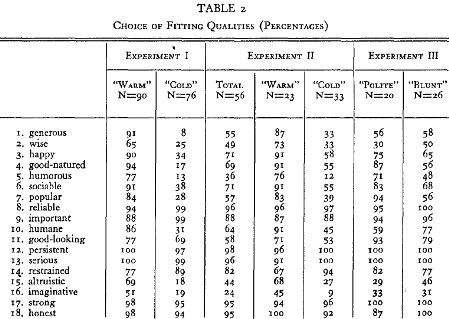
This trend is fully confirmed in the check-list choices. In Table 2 we report the frequency (in terms of percentages) with which each term in the check list was selected. For the sake of brevity of presentation we state the results for the positive term in each pair; the reader may determine the percentage of choices for the other term in each pair by subtracting the given figure from 100. To illustrate, under Condition A of the present experiment, 91 per cent of the subjects chose the designation "generous"; the remaining 9 per cent selected the designation "ungenerous." Occasionally, a subject would not state a choice for a particular pair. Therefore, the number of cases on which the figures are based is not always identical; however, the fluctuations were minor, with the exception of the category "good-looking— unattractive," which a larger proportion of subjects failed to answer.
We find:
1. There are extreme reversals between Groups A and B in the choice of fitting characteristics. Certain qualities are preponderantly assigned to the "warm" person, while the opposing qualities are equally prominent in the "cold" person. This holds for the qualities of (1) generosity, (2) shrewdness, (3) happiness, (4) irritability, (5) humor, (6) sociability, (7) popularity, (10) ruthlessness, (15) self-centeredness, (16) imaginativeness.
2. There is another group of qualities which is not affected by the transition from "warm" to "cold," or only slightly affected. These are: (8) reliability, (9) importance, (u) physical attractiveness, (12) persistence, (13) seriousness, (14) restraint, (17) strength, (18) honesty.
These results show that a change in one character-quality has produced a widespread change in the entire impression. Further, the written sketches show that the terms "warm-cold" did not simply add a new quality, but to some extent transformed the other characteristics. With this point we shall deal more explicitly in the experiments to follow.
That such transformations take place is also a matter of everyday experience. If a man is intelligent, this has an effect on the way in which we perceive his playfulness, happiness, friendliness. At the same time, this extensive change does not function indiscriminately. The "warm" person is not seen more favorably in all respects. There is a range of qualities, among them a number that are basic, which are not touched by the distinction between "warm" and "cold." Both remain equally honest, strong, serious, reliable, etc.
The latter result is of interest with reference to one possible interpretation of the findings. It might be supposed that the category "warm-cold" aroused a "mental set" or established a halo tending toward a consistently plus or minus evaluation. We observe here that this trend did not work in an indiscriminate manner, but was decisively limited at certain points. If we assume that the process of mutual influence took place in terms of the actual character of the qualities in question, it is not surprising that some will, by virtue of their content, remain unchanged.
The following will show that the subjects generally felt the qualities "warm-cold" to be of primary importance. We asked the subjects in certain of the groups to rank the terms of Lists A and B in order of their importance for determining their impression. Table 3, containing the distribution of rankings of "warm-cold," shows that these qualities ranked comparatively high. At the same time a considerable number of subjects relegated "cold" to the lowest position. That the rankings are not higher is due to the fact that the lists contained other central traits.
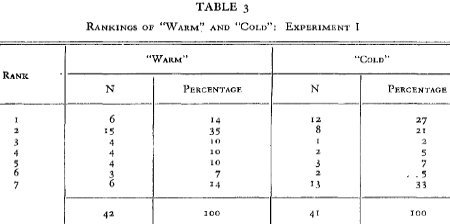
These data, as well as the ranking of the other traits not here reproduced, point to the following conclusions:
1. The given characteristics do not all have the same weight for the subject. He assigns to some a higher importance than to others.
2. The weight of a given characteristic varies—within limits*—from subject to subject.
Certain limitations of the check-list procedure need to be considered: (1) The subject's reactions are forced into an appearance of discreteness which they do not actually possess, as the written sketches show; (2) the check list requires the subject to choose between extreme characteristics, which he might prefer to avoid; (3) the quantitative data describe group trends; they do not represent adequately the form of the individual impression. Generally the individual responses exhibit much stronger trends in a consistently positive or negative direction. For these reasons we employ the check-list results primarily for the purpose of comparing group trends under different conditions. For this purpose the procedure is quite adequate.
B. Omission of a Central Quality
That the category "warm-cold" is significant for the total impression may be demonstrated also by omitting it from the series. This we do in the following experiment.
Experiment II
The procedure was identical with that of Experiment I, except that the terms "warm" and "cold" were omitted from the list read to the subject (intelligent - skillful - industrious - determined – practical - cautious). Also the check list was identical with that of Experiment I, save that "warm-cold" was added as the last pair. There were three groups, consisting of a total of 56 subjects.
Under these conditions the selection of fitting characteristics shows a significant change. The distribution of choices for the total group (see Table 2, column labeled "Total") now falls between the "warm" and "cold" variations of Experiment I. It appears that a more neutral impression has formed. The total group results are, however, largely a statistical artifact. An examination of the check-list choices of the subjects quickly revealed strong and consistent individual differences. They tended to be consistently positive or negative in their evaluations. It will be recalled that the terms "warm-cold" were added to the check list. This permitted us to subdivide the total group according to whether they judged the described person on the check list as "warm" or "cold." Of the entire group, 23 subjects (or 41 per cent) fell into the "warm" category. Our next step was to study the distribution of choices in the two subgroups. The results are clear: the two subgroups diverge consistently in the direction of the "warm" and the "cold" groups, respectively, of Experiment I. (See Table 2.) This is especially the case with the two "warm" series, which are virtually identical.
It is of interest that the omission of a term from the experimental list did not function entirely as an omission. Instead, the subjects inferred the corresponding quality in either the positive or negative direction. While not entirely conclusive, the results suggest that a full impression of a person cannot remain indifferent to a category as fundamental as the one in question, and that a trend is set up to include it in the impression on the basis of the given data. In later experiments too we have found a strong trend to reach out toward evaluations which were not contained in the original description.
C. Variation of a Peripheral Quality
Would a change of any character quality produce an effect as strong as that observed above? "Warm" and "cold" seem to be of special importance for our conception of a person. This was, in fact, the reason for selecting them for study. If there are central qualities, upon which the content of other qualities depends, and dependent qualities which are secondarily determined, it should be possible to distinguish them objectively. On this assumption the addition or omission of peripheral qualities should have smaller effects than those observed in Experiment I. We turn to this question in the following experiment.
Experiment III
The following lists were read, each to a different group:
A. intelligent—skillful—industrious—polite—determined—practical cautious
B. intelligent—skillful—industrious—blunt—determined—practical—cautious
The A group contained 19, the B group 26 subjects.
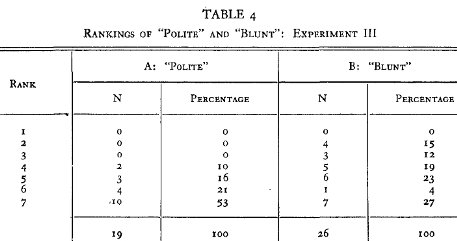
The changes introduced into the selection of fitting characteristics in the transition from "polite" to "blunt" were far weaker than those found in Experiment I (see Table 2). There is further evidence that the subjects themselves regarded these characteristics as relatively peripheral, especially the characteristic "polite." If we may take the rankings as an index, then we may conclude that a change in a peripheral trait produces a weaker effect on the total impression than does a change in a central trait. (Though the changes produced are weaker than those of Experiment I, they are nevertheless substantial. Possibly this is a consequence of the thinness of the impression, which responds easily to slight changes.)
D. Transformation from a Central to a Peripheral Quality
The preceding experiments have demonstrated a process of discrimination between central and peripheral qualities. We ask: Are certain qualities constantly central? Or is their functional value, too, dependent on the other characteristics?
Experiment IV
We selected for observation the quality "warm," which was demonstrated to exert a powerful effect on the total impression (Experiments I and II). The effect of the term was studied in the following two series:
A. obedient—weak—shallow—warm—unambitious— vain
B. vain — shrewd — unscrupulous — warm — shallow—envious
Immediately "warm" drops as a significant characteristic in relation to the others, as the distribution of rankings appearing in Table 5 shows.
(Compare Table 3 of Experiment I.)
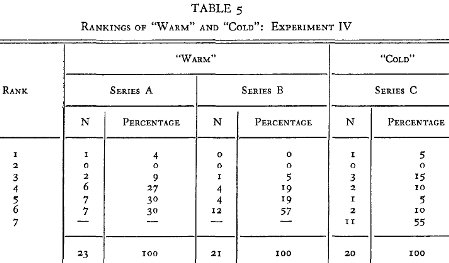
More enlightening are the subjects' comments. In Series A the quality "warm" is now seen as wholly dependent, dominated by others far more decisive.
I think the warmth within this person is a warmth emanating from a follower to a leader.
The term "warm" strikes one as being a dog-like affection rather than a bright friendliness. It is passive and without strength.
His submissiveness may lead people to think he is kind and warm.
A more extreme transformation is observed in Series B. In most instances the warmth of this person is felt to lack sincerity, as appears in the following protocols:
I assumed the person to appear warm rather than really to be warm.
He was warm only when it worked in with his scheme to get others over to his side. His warmth is not sincere.
A similar change was also observed in the content of "cold" in a further variation. The subject heard List B of Experiment I followed by Series C below, the task being to state whether the term "cold" had the same meaning in both lists.
C. intelligent—skillful—sincere—cold—conscientious— helpful—modest
All subjects reported a difference. The quality "cold" became peripheral for all in Series C. The following are representative comments:
The coldness of 1 (Experiment I) borders on ruthlessness; 2 analyses coldly to differentiate between right and wrong.
1 is cold inwardly and outwardly, while 2 is cold only superficially.
1: cold means lack of sympathy and understanding; 2: cold means somewhat formal in manner.
Coldness was the foremost characteristic of 1. In 2 it seemed not very important, a quality that would disappear after you came to know him.
That "cold" was transformed in the present series into a peripheral quality is also confirmed by the rankings reported in Table 5.
We conclude that a quality, central in one person, may undergo a change of content in another person, and become subsidiary. When central, the quality has a different content and weight than when it is subsidiary.
Here we observe directly a process of grouping in the course of which the content of a trait changes in relation to its surroundings. Secondly, we observe that the functional value of a trait, too—whether, for example, it becomes central or not—is a consequence of its relation to the set of surrounding traits. At the same time we are able to see more clearly the distinction between central and peripheral traits. It is inadequate to say that a central trait is more important, contributes more quantitatively to, or is more highly correlated with, the final impression than a peripheral trait. The latter formulations are true, but they fail to consider the qualitative process of mutual determination between traits, namely, that a central trait determines the content and the functional place of peripheral traits within the entire impression. In Series A, for example, the quality "warm" does not control the meaning of "weak," but is controlled by it.
The evidence may seem to support the conclusion that the same quality which is central in one impression becomes peripheral in another. Such an interpretation would, however, contain an ambiguity. While we may speak of relativity in the functional value of a trait within a person, in a deeper sense we have here the opposite of relativity. For the sense of "warm" (or "cold") of Experiment I has not suffered a change of evaluation under the present conditions. Quite the contrary; the terms in question change precisely because the subject does not see the possibility of finding in this person the same warmth he values so highly when he does meet it (correspondingly for coldness).
Experiment V
The preceding experiments have shown that the characteristics forming the basis of an impression do not contribute each a fixed, independent meaning, but that their content is itself partly a function of the environment of the other characteristics, of their mutual relations. We propose now to investigate more directly the manner in which the content of a given characteristic may undergo change.
Lists A and B were read to two separate groups (including 38 and 41 subjects respectively). The first three terms of the two lists are opposites; the final two terms are identical.
A. kind—wise—honest—calm—strong
B. cruel — shrewd — unscrupulous — calm — strong
The instructions were to write down synonyms for the given terms. The instructions read: "Suppose you had to describe this person in the same manner, but without using the terms you heard, what other terms would you use?" We are concerned with the synonyms given to the two final terms.
In Table 6 we list those synonyms of "calm" which occurred with different frequencies in the two groups. It will be seen that terms appear in one group which are not at all to be found in the other; further, some terms appear with considerably different frequencies under the two conditions. These do not, however, include the total group of synonyms; many scattered terms occurred equally in both groups.
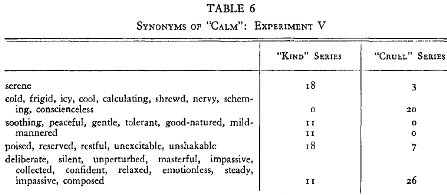
We may conclude that the quality "calm" did not, at least in some cases, function as an independent, fixed trait, but that its content was determined by its relation to the other terms. As a consequence, the quality "calm" was not the same under the two experimental conditions. In Series A it possessed an aspect of gentleness, while a grimmer side became prominent in Series B.
Essentially the same may be said of the final term, "strong." Again, some synonyms appear exclusively in one or the other groups, and in the expected directions.
Among these are:
Series A:
Fearless-helpful-just-forceful-courageous-reliable
Series B:
Ruthless-overbearing-overpowering-hard-inflexible-unbending-dominant
The data of Table 6 provide evidence of a tendency in the described direction, but its strength is probably underestimated. We have already mentioned that certain synonyms appeared frequently in both series. But it is not to be concluded that they therefore carried the same meaning. Doubtless the same terms were at times applied in the two groups with different meanings, precisely because the subjects were under the control of the factor being investigated. To mention one example: the term "quiet" often occurred as a synonym of "calm" in both groups, but the subjects may have intended a different meaning in the two cases. For this reason Table 6 may not reveal the full extent of the change introduced by the factor of embedding.
The preceding experiments permit the following conclusions:
1. There is a process of discrimination between central and peripheral traits. All traits do not have the same rank and value in the final impression. The change of a central trait may completely alter the impression, while the change of a peripheral trait has a far weaker effect (Experiments I, II, and III).
2. Both the cognitive content of a trait and its functional value are determined in relation to its surroundings (Experiment IV).
3. Some traits determine both the content and the function of other traits. The former we call central, the latter peripheral (Experiment IV).
II. THE FACTOR OF DIRECTION
If impressions of the kind here investigated are a summation of the effects of the separate characteristics, then an identical set of characteristics should produce a constant result. Is it possible to alter the impression without changing the particular characteristic? We investigate this question below.
Experiment VI
The following series are read, each to a different group:
A. intelligent—industrious—impulsive—critical— stubborn—envious
B. envious—stubborn—critical—impulsive—industrious—intelligent
There were 34 subjects in Group A, 24 in Group B.
The two series are identical with regard to their members, differing only in the order of succession of the latter. More particularly, Series A opens with qualities of high merit (intelligent— industrious), proceeds to qualities that permit of a better or poorer evaluation (impulsive — critical — stubborn), and closes with a dubious quality (envious). This order is reversed in Series B.
A considerable difference develops between the two groups taken as a whole. The impression produced by A is predominantly that of an able person who possesses certain shortcomings which do not, however, overshadow his merits. On the other hand, B impresses the majority as a "problem," whose abilities are hampered by his serious difficulties. Further, some of the qualities (e.g., impulsiveness, criticalness) are interpreted in a positive way under Condition A, while they take on, under Condition B, a negative color. This trend is not observed in all subjects, but it is found in the majority. A few illustrative extracts follow:
Series A
A person who knows what he wants and goes after it. He is impatient at people who are less gifted, and ambitious with those who stand in his way.
Is a forceful person, has his own convictions and is usually right about things. Is self-centered and desires his own way.
The person is intelligent and fortunately he puts his intelligence to work. That he is stubborn and impulsive may be due to the fact that he knows what he is saying and what he means and will not therefore give in easily to someone else's idea which he disagrees with.
Series B
This person's good qualities such as industry and intelligence are bound to be restricted by jealousy and stubbornness. The person is emotional. He is unsuccessful because he is weak and allows his bad points to cover up his good ones.
This individual is probably maladjusted because he is envious and impulsive.
In order to observe more directly the transition in question, the writer proceeded as follows. A new group (N=24) heard Series B, wrote the free sketch, and immediately thereafter wrote the sketch in response to Series A. They were also asked to comment on the relation between the two impressions. Under these conditions, with the transition occurring in the same subjects, 14 out of 24 claimed that their impression suffered a change, while the remaining 10 subjects reported no change. Some of the latter asserted that they had waited until the entire series was read before deciding upon their impression. The following are a few comments of the changing group:
You read the list in a different order and thereby caused a different type of person to come to mind. This one is smarter, more likeable, a go-getter, lively, headstrong, and with a will of his own; he goes after what he wants.
The first individual seems to show his envy and criticism more than the second one.
This man does not seem so bad as the first one. Somehow, he seems more intelligent, with his critical attitude helping that characteristic of intelligence, and he seems to be industrious, perhaps because he is envious and wants to get ahead. The check-list data appearing in Table 7 furnish quantitative support for the conclusions drawn from the written sketches.
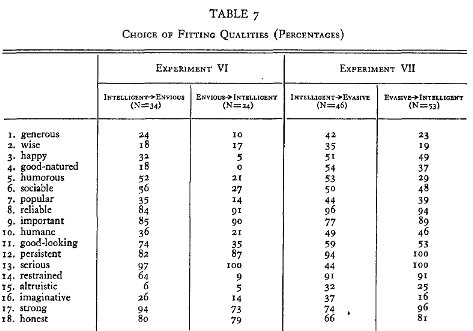
Under the given conditions the terms, the elements of the description, are identical, but the resulting impressions frequently are not the same. Further, the relations of the terms to one another have not been disturbed, as they may have been in Experiments I and II, with the addition and omission of parts. How can we understand the resulting difference?
The accounts of the subjects suggest that the first terms set up in most subjects a direction which then exerts a continuous effect on the latter terms. When the subject hears the first term, a broad, uncrystallized but directed impression is born. The next characteristic comes not as a separate item, but is related to the established direction. Quickly the view formed acquires a certain stability, so that later characteristics are fitted - if conditions permit - to the given direction.
Here we observe a factor of primacy guiding the development of an impression. This factor is not, however, to be understood in the sense of Ebbinghaus, but rather in a structural sense. It is not the sheer temporal position of the item which is important as much as the functional relation of its content to the content of the items following it.
Some further evidence with regard to this point is provided by the data with regard to ranking. We reproduce in Table 8 the rankings of the characteristic "envious" under the two conditions.
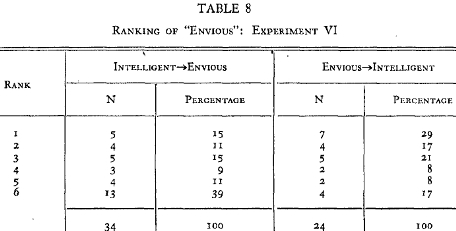
Experiment VII
It seemed desirable to repeat the preceding experiment with a new series. As before, we reversed the succession of terms. Unlike the preceding series, there is no gradual change in the merit of the given characteristics, but rather the abrupt introduction at the end (or at the beginning) of a highly dubious trait.
The series were:
A. intelligent—skillful—industrious—determined— practical—cautious—evasive
B. evasive—cautious—practical—determined—industrious—skillful—intelligent
While the results are, for reasons to be described, less clear than in the experiment preceding, there is still a definite tendency for A to produce a more favorable impression with greater frequency. We report below the more extreme protocols in each series.
Series A
He seems to be a man of very excellent character, though it is not unusual for one person to have all of those good qualities.
A scientist in an applied field, who does not like to discuss his work before it is completed. Retiring and careful - but brilliant. Works alone, does not like to be annoyed with questions. A very dynamic man.
A normal, intelligent person, who sounds as if he would be a good citizen, and of value to all who know him.
He seems to have at least two traits which are not consistent with the rest of his personality. Being cautious and evasive contradicts his positive qualities. Altogether, he is a most unattractive person—the two abovementioned traits overbalancing the others.
Series B
This is a man who has had to work for everything he wanted—therefore he is evasive, cautious and practical. He is naturally intelligent, but his struggles have made him hard.
He is out for himself, is very capable but tends to use his skill for his own benefit.
He is so determined to succeed that he relies on any means, making use of his cunning and evasive powers.
Questioning disclosed that, under the given conditions, the quality "evasive" produced unusual difficulty. Most subjects in both groups felt a contradiction between it and the series as a whole. In response to the question, "Were there any characteristics that did not fit with the others?" n out of 27 in Group A mentioned "evasive" while it was mentioned by 11 out of a total of 30 in Group B.
It is of interest to observe how this crucial term was dealt with by individual subjects. Some in Group A felt unable to reconcile it with the view they had formed; consequently they relegated it to a subsidiary position and, in the most extreme cases, completely excluded it. Others reported the opposite effect: the final term completely undid their impression and forced a new view. The following comments are illustrative:
Series A
I put this characteristic in the background and said it may be a dependent characteristic of the person, which does not dominate his personality, and does not influence his actions to a large extent.
I excluded it because the other characteristics which fitted together so well were so much more predominant. In my first impression it was left out completely.
It changed my entire idea of the person— changing his attitude toward others, the type of position he'd be likely to hold, the amount of happiness he'd have—and it gave a certain amount of change of character (even for traits not mentioned), and a tendency to think of the person as somewhat sneaky or sly.
Similar reactions occur in Group B, but with changed frequencies.
The importance of the order of impressions of a person in daily experience is a matter of general observation and is perhaps related to the process under investigation. It may be the basis for the importance attached to first impressions. It is a matter of general experience that we may have a "wrong slant" on a person, because certain characteristics first observed are given a central position when they are actually subsidiary, or vice versa.
Experiment VIII
We studied the factor of direction in yet another way. Series A of Experiment VI was divided in two parts and presented to a new group as a description of two persons. The new series were:
A. intelligent—industrious—impulsive
B. critical—stubborn—envious
Procedure, (I) Series A was read to this group (Group 1), followed by the written sketch and the check list. (2) The subjects were instructed that they would hear a new group of terms describing a second person. Series B was read and' the usual information was obtained. (3) Upon completion of the second task the subjects were informed that the two lists described a single person. They were instructed to form an impression corresponding to the entire list of terms. Certain questions were subsequently asked concerning the last step which will be described below.
A control group (Group 2) responded only to the entire list of six terms (as in Series A of Experiment VI), and answered some of the final questions.
We are concerned mainly to see how Group 1 dealt with the final task, the establishing of an impression based on the two smaller series. That Lists A and B were widely different will be clear in the check-list results of Table 9.
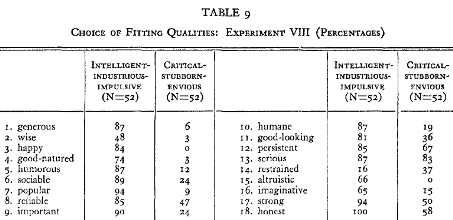
Most subjects of Group 1 expressed astonishment at the final information (of Step 3) and showed some reluctance to proceed. In response to the question, "Did you experience difficulty in forming an impression on the basis of the six terms," the majority of Group 1 (32 out of 52) replied in the affirmative. The reasons given were highly uniform: the two sets of traits seemed entirely contradictory.
I had seen the two sets of characteristics as opposing each other. It was hard to envision all these contradictory traits in one person.
The person seemed to be a mass of contradictions.
He seemed a dual personality. There are two directions in this person.
On the other hand, only a minority in Group 2 (9 out of 24) report any difficulty. Further, the reasons given by the latter are entirely different from those of Group 1. These subjects speak in very general terms, as:
These characteristics are possessed by everyone in some degree or other. The terms do not give an inclusive picture. Only two subjects in Group 2 mention contradiction between traits as a source of difficulty.
The formation of the complete impression proceeds differently in the two groups. Series A and B are at first referred, in Group 1, to entirely different persons. Each is completed in its direction, and the fact that they come successively seems to enhance the contrast between them. It is therefore difficult for them to enter the new impression. Some subjects are unable to reconcile the two directions completely; in consequence their divergence becomes the paramount fact, as the following protocols illustrate:
The directions reacted on each other and were modified, so that the pull in each direction is now less strong. This gives a Jekyll and Hyde appearance to this person.
I applied A to the business half of the man—as he appeared and acted during working hours. B I referred to the man's social life.
The independent development of A and B is on the other hand prevented in Group 2, where they function from the start as parts of one description.
This conclusion is in general confirmed by the following observation. To the question: "Did you proceed by combining the two earlier impressions or by forming a new impression?" the following responses are obtained: (a) 33 of 52 subjects answer that they formed a new impression, different from either A or B; 12 subjects speak of combining the two impressions, while 7 subjects assert that they resorted to both procedures. The following are typical responses in the first subgroup:
I couldn't combine the personalities of A and B. I formed an entirely new impression.
I can conceive of the two sets of characteristics in one person, but I cannot conceive of my impressions of them as belonging to one person.
As I have set down the impressions, one is exactly the opposite of the other. But I can fit the six characteristics to one person.
That the terms of Series A and B often suffered considerable change when they were viewed as part of one series becomes evident in the replies to another question. The subjects were asked, "Did the terms of the series A and B retain for you their first meaning or did they change?" Most subjects describe a change in one or more of the traits, of which the following are representative:
In A impulsive grew out of imaginativeness; now it has more the quality of hastiness. Industriousness becomes more self-centered. Critical is now not a derisive but rather a constructive activity. Stubborn had an entirely personal meaning; now it refers to being set in one's ideas.
The tenor of most replies is well represented by the following comment: When the two came together, a modification occurred as well as a limiting boundary to the qualities to which each was referred.
III. STRONGLY SIMPLIFIED IMPRESSIONS
To a marked degree the impressions here examined possess a strongly unified character. At the same time they lack the nuances and discriminations that a full-fledged understanding of another person provides. Therefore they can be easily dominated by a single direction. We propose now to observe in a more direct and extreme manner the formation of a global impression.
Experiment IX
We select from the series of Experiment I three terms: intelligent – skillful – warm - all referring to-strong positive characteristics. These form the basis of judgment. The results appear in Table 10.
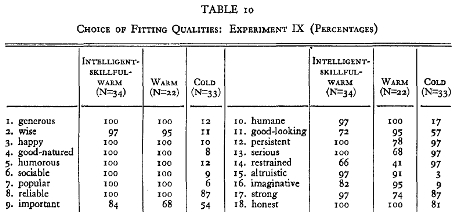
There develops a one-directed impression, far stronger than any observed in the preceding experiments. The written sketches, too, are unanimously enthusiastic. The impression also develops effortlessly. Negative characteristics hardly intrude. That this fails to happen raises a problem. Many negative qualities could quite understandably be living together with those given. But the subjects do not as a rule complete them in this direction. This, indeed, they seem to avoid.
The next step was to observe an impression based on a single trait. There are two groups; one group is instructed to select from the check list those characteristics which belong to a "warm" person, the second group those belonging to a "cold" person. The results appear in Table 10.
In order to show more clearly the range of qualities affected by the given terms we constructed a second check list (Check List II) to which the subjects were to respond in the manner already described. The results are reported in Table II.
A remarkably wide range of qualities is embraced in the dimension "warm-cold." It has reference to temperamental characteristics (e.g., optimism, humor, happiness), to basic relations to the group (e.g., generosity, sociability, popularity), to strength of character (e.g., persistence, honesty). It even includes a reference to physical characteristics, evident in the virtually unanimous characterizations of the warm person as short, stout, and ruddy, and in the opposed characterizations of the cold person.
The differences between "warm" and "cold" are now even more considerable than those observed in Experiment I. No qualities remain untouched. But even under these extreme conditions the characterizations do not become indiscriminately positive or negative. "Warm" stands for very positive qualities, but it also carries the sense of a certain easy-goingness, of a lack of restraint and persistence, qualities which are eminently present in "cold." A simplified impression is not to be simply identified with a failure to make distinctions or qualifications. Rather, what we find is that in a global view the distinctions are drawn bluntly.
The consistent tendency for the distribution of choices to be less extreme in Experiment I requires the revision of an earlier formulation. We have said that central qualities determine the content and functional value of peripheral qualities. It can now be seen that the central characteristics, while imposing their direction upon the total impression, were themselves affected by the surrounding characteristics.
Upon the conclusion of the experiments, the subjects were asked to state the reason for their choice of one predominant direction in their characterizations. All agreed that they felt such a tendency. Some cannot explain it, saying, in the words of one subject: "I do not know the reason; only that this is the way it 'hit' me at the moment"; or: "I did not consciously mean to choose the positive traits." Most subjects, however, are explicit in stating that the given traits seemed to require completion in one direction. The following statements are representative:
These qualities initiate other qualities. A man who is warm would be friendly, consequently happy. If he is intelligent, he would be honest.
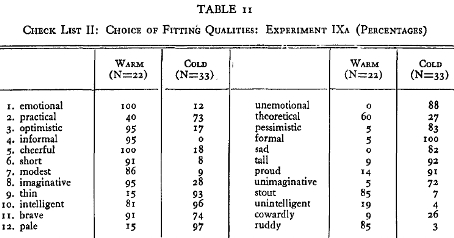
The given characteristics, though very general, were good characteristics. Therefore other good characteristics seemed to belong. When, for example, I think of a person as warm, I mean that he couldn't be ugly.
This was the tenor of most statements. A few show factors at work of a somewhat different kind, of interest to the student of personality, as:
I naturally picked the best trait because I hoped the person would be that way.
I went in the positive direction because I would like to be all those things.
It is of interest for the theory of our problem that there are terms which simultaneously contain implications for wide regions of the person. Many terms denoting personal characteristics show the same property. They do not observe a strict division of labor, each pointing neatly to one specific characteristic; rather, each sweeps over a wide area and affects it in a definite manner.Some would say that this is a semantic problem. To do so would be, however, to beg the question by disposing of the psychological process that gives rise to the semantic problem. What requires explanation is how a term, and a highly "subjective" one at that, refers so consistently to so wide a region of personal qualities. It seems similarly unfruitful to call these judgments stereotypes. The meaning of stereotype is itself badly in need of psychological clarification. Indeed, in the light of our observations, a stereotype appears (in a first approximation) to be a central quality belonging to an extremely simplified impression.
We propose that there is, under the given conditions, a tendency to grasp the characteristics in their most outspoken, most unqualified sense, and on that basis to complete the impression. The subject aims at a clear view; he therefore takes the given terms in their most complete sense. (What is said here with regard to the present experiment seems to apply also to the preceding experiments. In each case the subject's impression is a blunt, definite characterization. It lacks depth but not definiteness. Even when the view is of a mediocre character, it is outspokenly so.) The comments of the subjects are in agreement with the present interpretation.
IV. SIMILARITY AND DIFFERENCE OF IMPRESSIONS
The preceding discussion has definite consequences for the perception of identity and difference between the characteristics of different persons. Of these the most significant for theory is the proposition that a given trait in two different persons may not be the same trait, and, contrariwise, that two different traits may be functionally identical in two different persons. We turn now to an investigation of some conditions which determine similarity and difference between personal qualities.
Experiment X
I. The group has before it Sets 1, 2, 3, and 4 with instructions to state (I) which of the other three sets most resembles Set 1, and (2) which most resembles Set 2.
SET 1: quick, skillful, helpful
SET 2: quick, clumsy, helpful
SET 3: slow, skillfull, helpful
SET 4: slow, clumsy, helpful
One quality—"helpful"—remains constant in all sets. The other two qualities appear in their positive form in Set 1, and are changed to their opposites singly and together in the three other sets. A remarkable uniformity appears in the findings, reported in Table 12.
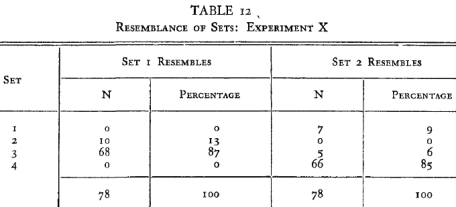
Set 1 is equated with Set 3 in 87 per cent of the cases, while its similarity to Set 2 is reported in only 13 per cent of the cases. Similarly, Set 2 is asserted to resemble Set 4 in 85 per cent of the cases, while the resemblance to Set 1 drops to 9 per cent.
The choice of similar sets cannot in this case be determined merely on the basis of the number of "identical elements," for on this criterion Sets 2 and 3 are equally similar to 1, while Sets 1 and 4 are equally similar to 2. What factors may be said to determine the decisions with regard to similarity and difference?
We come somewhat closer to an answer in the replies to the following question: "Which characteristics in the other sets resemble most closely (a) 'quick' of Set 1? (b) 'quick' of Set 2? (c) 'helpful' of Set 1? (d) 'helpful' of Set 2?" The results appear in Table 13.
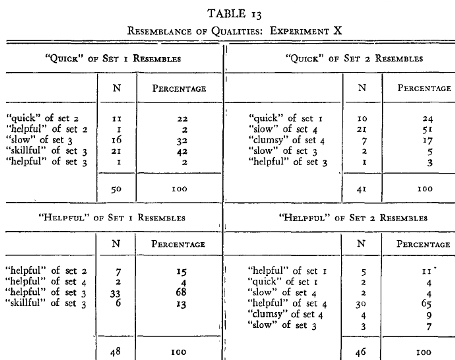
We see that qualities which, abstractly taken, are identical, are infrequently equated, while qualities which are abstractly opposed are equated with greater frequency. For example, the quality "quick" of Sets 1 and 2 is matched in only 22 and 25 per cent of the cases, respectively, while "quick" of Set 1 is, in 32 per cent of the cases, matched with "slow" of Set 3, and "quick" of Set 2 with "slow" of Set 4 in 51 per cent of the cases.
At this point the reports of the subjects become very helpful. They were requested at the conclusion to state in writing whether the quality "quick" in Sets 1 and 2 was identical or different, together with their reasons, and similarly to compare the quality "slow" in Sets 3 and 4. The written accounts permit of certain conclusions, which are stated below.
I. The content of the quality changes with a change in its environment.
The protocols Below, which are typical, will show that the "quicks" of Sets 1 and 2 are phenomenally different, and similarly for the "slows" of Sets 3 and 4.
The quickness of 1 is one of assurance, of smoothness of movement; that of 2 is a forced quickness, in an effort to be helpful.
1 is fast in a smooth, easy-flowing way; the other (2) is quick in a bustling way—the kind that rushes up immediately at your request and tips over the lamps.
3 takes his time in a deliberate way; 4 would like to work quickly, but cannot— there is something painful in his slowness. 3 is slow in a methodical, sure way, aiming toward perfection; in 4 it implies a certain heaviness, torpor.
2. The dynamic sources of the quality are relationally determined.
In the protocols we observe a process of mutual determination between traits. They are grasped as not simply contiguous to one another but in dynamic relation, in which one is determined by, or springs from, the other.
1 is quick because he is skillful; 2 is clumsy because he is so fast. Great skill gave rise to the speed of 1, whereas 2 is clumsy because he does everything so quickly.
The quality slow is, in person 3, something deliberately cultivated, in order to attain a higher order of skill.
In 3 slowness indicates care, pride in work well-done. Slowness in 4 indicates sluggishness, poor motor coordination, some physical retardation.
Speed and skill are not connected as are speed and clumsiness. Without exception, "quick" is perceived to spring from skill (skillful->quick); but the vector in Set 2 is reversed, "clumsy" becoming a consequence of speed (clumsy<-quick). While Sets 1 and 3 are identical with regard to the vectors, Set 2 is not equivalent to 4, the slowness and clumsiness of 4 being sensed as part of a single process, such as sluggishness and general retardation (slow<->clumsy).
3. Dynamic consequences are grasped in the interaction of qualities.
"Quick" and "skillful" (as well as "slow" and "skillful") are felt as cooperating, whereas "quick" and "clumsy" cancel one another.
2 drops everything fast. He is fast but accomplishes nothing. The clumsy man might be better off if he were slow.
The second person is futile; he is quick to come to your aid and also quick to get in your way and under your hair.
I can afford to be quick; 2 would be far better off if he took things more slowly.
In the light of these comments, which are representative, we are able to formulate the prevailing direction of the relations within the sets.
In Sets 1 and 3 the prevailing structure may be represented as:

"Quick-slow" derive their concrete character from the quality "skillful"; these in turn stand in a relation of harmony to "helpful," in the sense that they form a proper basis for it and make it possible. In Sets 2 and 4 the characteristic structures are as follows:

But now these stand in a relation of inherent contradiction to the quality "helpful," the fulfillment of which they negate.
Our results contain a proportion of cases (see Tables 12 and 13) that are contrary to the described general trend. These do equate the characteristic of 1 and 2 and of 3 and 4. They require explanation. It is especially important to decide whether the disagreements are capricious or whether they have an understandable basis. As a rule we find in these cases that the given quality is viewed in a narrower, more limited way. For example, these subjects view "quick" of Sets 1 and 2 in terms of sheer tempo, deliberately excluding for the moment considerations of fitness. The following protocols are illustrative:
These persons' reactions to stimuli are both quick, even though the results of their actions are in opposite directions.
They are both quick, but they differ in the success of their actions.
The two terms are basically the same, for both would execute their tasks with their individual maximum speed.
II. The reader will readily think of other sets of characteristics involving similar processes. In view of the fact that such analyses have not been previously reported, we select for brief description a few additional examples. The task was to state whether the term "aggressive" was alike or different in Sets 1 and 2, and 3 and 4, respectively. This example will be of particular interest to psychologists, in view of current discussions of aggressiveness.
SET 1: active, helpful, aggressive
SET 2: lazy, unhelpful, aggressive
SET 3: weak, sensitive, aggressive
SET 4: strong, self-centered, aggressive
Nineteen out of 20 subjects judge the term to be different in Sets 1 and 2; 17 out of 20 judge it to be different in Sets 3 and 4. Some representative reports follow:
The aggressiveness of 1 is friendly, open, and forceful; 2 will be aggressive when something offends him.
The aggressiveness of 1 is an expression of confidence in his abilities, of his strength of will and mind; in 2 it is a defensive measure to cover sensitivity.
3 will be aggressive to try to hide his weakness. The aggressiveness of 4 is a natural result of his strength and self-centeredness.
4 is aggressive because he has needs to be satisfied and wishes nothing to stand in his way; 3 has the aggressiveness of self-pity and indecision.
In nearly all cases the sources of aggression and its objects are sensed to be different. In consequence, the form it takes and its very psychological content become different in the series compared.
Substantially the same results are observed in another group in the comparison of "unaggressive" in Sets 1 and 2 below.
SET 1: active, helpful, unaggressive
SET 2: weak, sensitive, unaggressive
Twenty-eight out of 30 subjects call "unaggressive" different in the two series. Some of their reasons follow:
Unaggressive in 1 might mean that he does not push or force his way into things. In the second case it may mean meekness or fear of people.
1 does not care to be aggressive; 2 lacks the stamina for it.
2 does not fight back at the world nor try to rise above his weaknesses.
The word "aggressive" must have the same connotations in both cases; otherwise why not use different terms to express different things?
III. The second and third terms in Sets 1 and 2 below were compared, respectively.
SET 1: intelligent, critical, stubborn
SET 2: impulsive, critical, stubborn
All subjects in a group of 31 judged the term "critical" to be different in the two sets; while 19 (or 61 per cent) judged "stubborn" as different. A few of the remarks follow:
Critical:
1 is critical because he is intelligent; 2 because he is impulsive.
The intelligent individual is critical in a constructive manner; the impulsive one probably hurls criticism unthinkingly.
The intelligent person may be critical in a completely impersonal way; 2 may be critical of people, their actions, their dress, etc.
Stubborn:
The stubbornness of an intelligent person is more likely to be based on reason and it can be affected by reasoning.
The intelligent person might be stubborn about important things, things that mean something to him, that he knows something about; whereas an impulsive person might be stubborn just to be contrary.
An intelligent person may be stubborn because he has a reason for it and thinks it's the best thing to do, while an impulsive person may be stubborn because at the moment he feels like it.
Some representative statements defending the identity of "stubborn" in the two series follow:
Stubbornness to me is the same in any language. Of course, an intelligent person may have a better reason for being stubborn than an impulsive one, but that does not necessarily change the degree of stubbornness.
Both refuse to admit to anything that does not coincide with their opinion.
In my opinion there is only one kind of stubbornness—an unswerving desire either to do or not to do a certain thing.
IV. In the following series the second and third terms were to be compared:
SET 1: warm, witty, persuasive
SET 2: cold, witty, persuasive
Twenty-seven of 30 subjects judged "persuasive" as different; all judged "witty" to be different. A few of the comments follow:
Witty:
1 laughs with the audience; 2 is either laughing at or trying to make others laugh at some one. 2 is satirical, not humorous.
1 has a jolly and happy-go-lucky wit. 2 will use wit as one uses a bow and arrow— with precision. He will have a target which will not be missed.
The wit of the warm person touches the heart. The cold person's wit is touched with irony.
Persuasive:
1 is persuasive in trying to help others; 2 in trying to help himself.
2 may persuade through fear.
2 would be detached in his arguments; 1 would appeal more to the inner emotional being of others.
V. The term "gay" was compared in the following series:
SET 1: gay, intelligent, industrious
SET 2: gay, stupid, lazy
Twenty-seven of 30 subjects call "gay" different. Some representative reasons follow:
They may both be equally gay, but the former is different. The stupid person can be gay over serious, sad matters, while the intelligent person is gay with reason.
The first person's gaiety comes from fullness of life; 2 is gay because he knows no belter.
1 knows when to be gay and when not to be.
The gaiety of 1 is active and energetic; the gaiety of 2 is passive.
The intelligent person is gay in an intelligent way.
They are the same - gaiety has no relation to intelligence and industriousness.
The foregoing observations describe a process of relational determination of character-qualities. A given quality derives its full concrete content from its place within the system formed by the relations of the qualities. Some qualities are seen as a dynamic outgrowth of determining qualities. Qualities are seen to stand in a relation of harmony or contradiction to others within the system. These processes set requirements for the comparison of impressions. Identical qualities in different structures may cease to be identical: the vectors out of which they grow may alter, with the consequence that their very content undergoes radical change. In the extreme case, the same quality in two persons will have different, even opposed, meanings, while two opposed qualities will have the same function within their respective structures.
Discussion I
The investigations here reported have their starting-point in one problem and converge on one basic conclusion. In different ways the observations have demonstrated that forming an impression is an organized process; that characteristics are perceived in their dynamic relations; that central qualities are discovered, leading to the distinction between them and peripheral qualities; that relations of harmony and contradiction are observed. To know a person is to have a grasp of a particular structure.
Before proceeding it may be helpful to note two preliminary points. First: For the sake of convenience of expression we speak in this discussion of forming an impression of a person, though our observations are restricted entirely to impressions based on descriptive materials. We do not intend to imply that observations of actual persons would not involve other processes which we have failed to find under the present conditions; we are certain that they would. But we see no reason to doubt that the basic features we were able to observe are also present in the judgment of actual persons. Secondly: We have not dealt in this investigation with the role of individual differences, of which the most obvious would be the effect of the subject's own personal qualities on the nature of his impression. Though the issue of individual differences is unquestionably important, it seemed desirable to turn first to those processes which hold generally, despite individual differences. A proper study of individual differences can best be pursued when a minimum theoretical clarification has been reached.
Let us briefly reformulate the main points in the procedure of our subjects:
1. There is an attempt to form an impression of the entire person. The subject can see the person only as a unit he cannot form an impression of one-half or of one-quarter of the person. This is the case even when the factual basis is meager; the impression then strives to become complete, reaching out toward other compatible qualities. The subject seeks to reach the core of the person through the trait or traits.
2. As soon as two or more traits are understood to belong to one person, they cease to exist as isolated traits, and come into immediate dynamic interaction. The subject perceives not this and that quality, but the two entering into a particular relation. There takes place a process of organization in the course of which the traits order themselves into a structure. It may be said that the traits lead an intensely social life, striving to join each other in a closely organized system. The representation in us of the character of another person possesses in a striking sense certain of the qualities of a system.
3. In the course of this process some characteristics are discovered to be central. The whole system of relations determines which will become central. These set the direction for the further view of the person and for the concretization of the dependent traits. As a rule the several traits do not have equal weight. And it is not until we have found the center that we experience the assurance of having come near to an understanding of the person.
4. The single trait possesses the property of a part in a whole. A change in a single trait may alter not that aspect alone, but many others—at times all. As soon as we isolate a trait we not only lose the distinctive organization of the person; the trait itself becomes abstract. The trait develops its full content and weight only when it finds its place within the whole impression.
5. Each trait is a trait of the entire person. It refers to a characteristic form of action or attitude which belongs to the person as a whole. In this sense we may speak of traits as possessing the properties of Ehrenfels-qualities. Traits are not to be considered as referring to different regions of the personality, on the analogy of geographical regions which border on another.
6. Each trait functions as a representative of the person. We do not experience anonymous traits the particular organization of which constitutes the identity of the person. Rather the entire person speaks through each of his qualities, though not with the same clearness. 7. In the process of mutual interaction the concrete character of each trait is developed in accordance with the dynamic requirements set for it by its environment. There is involved an understanding of necessary consequences following from certain given characteristics for others. The envy of a proud man is, for example, seen to have a different basis from the envy of a modest man.
8. On this basis consistencies and contradictions are discovered. Certain qualities are seen to cooperate; others to negate each other. But we are not content simply to note inconsistencies or to let them sit where they are. The contradiction is puzzling, and prompts us to look more deeply. Disturbing factors arouse a trend to maintain the unity of the impression, to search for the most sensible way in which the characteristics could exist together, or to decide that we have not found the key to the person. We feel that proper understanding would eliminate, not the presence of inner tensions and inconsistencies, but of sheer contradiction. (It may be relevant to point out that the very sense of one trait being in contradiction to others would not arise if we were not oriented to the entire person. Without the assumption of a unitary person there would be just different traits.)
9. It follows that the content and functional value of a trait changes with the given context. This statement expresses for our problem a principle formulated in gestalt theory with regard to the identity of parts in different structures (8, 10). A trait central in one person may be seen as secondary in another. Or a quality which is now referred to the person may in another case be referred to outer conditions. (In the extreme case a quality may be neglected, because it does not touch what is important in the person.)
We conclude that the formation and change of impressions consist of specific processes of organization. Further, it seems probable that these processes are not specific to impressions of persons alone. It is a task for future investigation to determine whether processes of this order are at work in other important regions of psychology, such as in forming the view of a group, or of the relations between one person and another.
Discussion II
It may be of interest to relate the assumptions underlying the naive procedure of our subjects to certain customary formulations, (1) It should now be clear that the subjects express certain definite assumptions concerning the structure of a personality. The gaining of an impression is for them not a process of fixing each trait in isolation and noting its meaning. If they proceeded in this way the traits would remain abstract, lacking just the content and function which makes them living traits. In effect our subjects are in glaring disagreement with the elementaristic thesis which assumes independent traits (or traits connected only in a statistical sense) of constant content. (2) At the same time the procedure of our subjects departs from another customary formulation. It is equally far from the observed facts to describe the process as the forming of a homogeneous, undifferentiated "general impression." The uriity perceived by the observer contains groupings the parts of which are in more intimate connection with each other than they are with parts of other groupings. Discrimination of different aspects of the person and distinctions of a functional order are essential parts of the process. We may even distinguish different degrees of unity in persons. Increasing clearness in understanding another depends on the increased articulation of these distinctions. But in the process these continue to have the properties of parts in a single structure.
If we may for the purpose of discussion assume that the naive procedure is based on a sound conception of the structure of personality, it would by no means follow that it is therefore free from misconceptions and distortions. But in that case the nature of errors in judgment would have to be understood in a particular way. It would be necessary to derive the errors from characteristics of the organizational processes in judgment. The present investigation is not without some hints for this problem. It points to the danger of forcing the subject to judge artificially isolated traits—a procedure almost universally followed in rating studies—and to the necessity of providing optimal conditions for judging the place and weight of a characteristic within the person (unless of course the judgment of isolated traits is required by the particular problem). Under such conditions we might discover an improvement in the quality of judgment and in agreement between judges. At the same time this investigation contains some suggestions for the study of errors in factors such as oversimplification leading to "too good" an impression, viewing a trait outside its context or in an inappropriate context.
Discussion III
Returning to the main theoretical conceptions described earlier it is necessary to mention a variant of Proposition I, which we have failed so far to consider and in relation to which we will be able to state more precisely a central feature of Proposition II. It would be a possible hypothesis that in the course of forming an impression each trait interacts with one or more of the others, and that the total impression is the summation of these effects. The impression would accordingly be derived from the separate interaction of the components, which might be represented as follows:
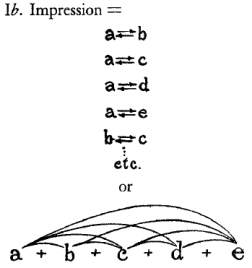
It is important to note that this formulation is in a fundamental regard different from Proposition II. The latter proposition asserts that each trait is seen to stand in a particular relation to the others as part of a complete view. The entire view possesses the formal properties of a structure, the form of which cannot be derived from the summation of the individual relations. In the same manner that the content of each of a pair of traits can be determined fully only by reference to their mutual relation, so the content of each relation can be determined fully only with reference to the structure of relations of which it is a part. This we may illustrate with the example of a geometrical figure such as a pyramid, each part of which (e.g., the vertex) implicitly refers to the entire figure. We would propose that this is the basis for the discovery of central and peripheral traits and for assertions such as that a given person is "integrated," restricted, etc.
On the other hand, the notion of structure is denied in all propositions of the form I, including Ib. In the latter, an assumption is made concerning the interaction of qualities, which has the effect of altering the character of the elements. Once we have taken account of this change, we have in the final formulation again a sum of (now changed) elements:
Ib. Impression = a + b + c + d + e
In still another regard there is a difference between Propositions II and Ib. This has to do with the nature of the interaction between the traits. In terms of Proposition II the character of interaction is determined by the particular qualities that enter into the relation (e.g., "warm-witty" or "cold-witty"). It is doubtful however whether a theory which refuses to admit relational processes in the formation of a whole impression would admit the same relational processes in the interaction of one trait with another.
In view of the fact that Proposition Ib has not, as far as we know, been explicitly formulated with reference to the present problem, it becomes necessary to do so here, and especially to state the process of interaction in such a manner as to be consistent with it. This we might do best by applying certain current conceptions. We could speak of traits as "conditioned verbal reactions," each of which possesses a particular "strength" and range of generalization. Interaction between traits would accordingly be assimilated to the schema of differential conditioning to single stimuli and to stimuli in combination, perhaps after the manner of the recent treatment of "stimulus configurations" by Hull (4,5).
How consistent would this interpretation be with the observations we have reported? It seems to us that there are grave difficulties in the way of such an interpretation. In so far as the terms of conditioning are at all intelligible with reference to our problem, the process of interaction can be understood only as a quantitative increase or diminution in a response. This is not, however, the essential characteristic of interaction as we have observed it, which consists in a change of content and function. The gaiety of an intelligent man is not more or less than the gaiety of a stupid man; it is different in quality. Further, the conditioning account seems to contain no principle that would make clear the particular direction interaction takes.
Here we may mention a more general point. We have referred earlier to the comparative ease with which complex situations in another person are perceived. If traits were perceived separately, we would expect to encounter the same difficulties in forming a view of a person that we meet in learning a list of unrelated words. That we are able to encompass the entire person in one sweep seems to be due to the structured character of the impression.
In terms of an interaction theory of component elements, the difficulty in surveying a person should be even greater than in the formulation of Proposition I, since the former must deal with the elements of the latter plus a large number of added factors.
Discussion IV
In order to retain a necessary distinction between the process of forming an impression and the actual organization of traits in a person, we have spoken as if nothing were known of the latter. While we cannot deal with the latter problem, one investigation is of particular relevance to the present discussion. We refer to the famous investigation of Hartshorne and May (3), who studied in a variety of situations the tendencies in groups of children to act honestly in such widely varied matters as copying, returning of money, correcting one's school work, etc. The relations between the actions of children in the different situations were studied by means of statistical correlations. These were generally low. On the basis of these results the important conclusion was drawn that qualities such as honesty are not consistent characteristics of the child but specific habits acquired in particular situations, that "neither deceit, nor its opposite, honesty, are unified character traits, but rather specific functions of life situations." Having accepted this conclusion, equally fundamental consequences were drawn for character education of children.
Abstracting from the many things that might be said about this work, we point out only that its conclusion is not proven because of the failure to consider the structural character of personality traits. As G. W. Allport has pointed out, we may not assume that a particular act, say the clandestine change by a pupil of an answer on a school test, has the same psychological meaning in all cases. Once this point is realized, its consequences for the thesis of Hartshorne and May become quite threatening. Let us consider a few of the possibilities in the situation, which would be classified as follows by Hartshorne and May:
Honest
1. The child wants to alter his answer on a test but fears he will be caught.
2. He does not change because he is indifferent to the grade.
Dishonest
1. The child changes his answer because he is devoted to his teacher and anxious not to lose her regard.
2. He cannot restrain the impulse to change the wrong answer into the answer he now knows to be correct.
Psychologically, none of these acts are correctly classified. Further, two of these are classified in precisely the wrong way. The child who wishes to cheat but is afraid does not belong in the honest category, while the child who cannot bear to leave the wrong answer uncorrected does not necessarily deserve to be called dishonest. We do not intend to say that the psychological significance of the reactions was as a rule misinterpreted; for the sake of illustration we have chosen admittedly extreme examples. But the failure to consider the psychological content introduces a serious doubt concerning the conclusions reached by Hartshorne and May.
Discussion V
A far richer field for the observation of the processes here considered would be the impressions formed of actual people. Concrete experience with persons possesses a substantial quality and produces a host of effects which have no room for growth in the ephemeral impressions of this investigation. The fact that we are ourselves changed by living people, that we observe them in movement and growth, introduces factors and forces of a new order. In comparison with these, momentary impressions based on descriptions, or even the full view of the person at a given moment, are only partial aspects of a broader process.
In such investigation some of the problems we have considered would reappear and might gain a larger application. Other problems, which were of necessity excluded from the present investigation, could be clarified in such an approach. We mention one which is of particular importance. It was a constant feature of our procedure to provide the subject with the traits of a person; but in actual observation the discovery of the traits in a person is a vital part of the process of establishing an impression. Since observation gives us only concrete acts and qualities, the application of a trait to a person becomes itself a problem. Is characterization by a trait for example a statistical generalization from a number of instances? Or is it the consequence of discovering a quality within the setting of the entire impression, which may therefore be reached in a single instance? In the latter case, repeated observation would provide not simply additional instances for a statistical conclusion, but rather a check on the genuineness of the earlier observation, as well as a clarification of its limiting conditions. Proceeding in this manner, it should be possible to decide whether the discovery of a trait itself involves processes of a strutural nature. Only direct investigation based on the observation of persons can furnish answers to these questions.
In still another regard did our investigation limit the range of observation. In the views formed of living persons past experience plays a great role. The impression itself has a history and continuity as it extends over considerable periods of time, while factors of motivation become important in determining its stability and resistance to change.
Even within the limits of the present study factors of past experience were highly important. When the subject formed a view on the basis of the given description, he as a rule referred to a contemporary, at no time to characters that may have lived in the past; he located the person in this country, never in other countries. Further, experiments we have not here reported showed unmistakably that an identical series of traits produced distinct impressions depending on whether we identified the person as a man or woman, as a child or adult. Distinctions of this order clearly depend on a definite kind of knowledge obtained in the past. Indeed, the very possibility of grasping the meaning of a trait presupposes that it had been observed and understood.
That experience enters in these instances as a necessary factor seems clear, but the statement would be misleading if we did not add that the possibility of such experience itself presupposes a capacity to observe and realize the qualities and dynamic relations here described. The assertion that the properties of the impression depend on past experience can only mean that these were once directly perceived. In this connection we may refer to certain observations of Kohler (6, p. 234) concerning our understanding of feelings in others which we have not observed in ourselves, or in the absence of relevant previous experiences. In his comprehensive discussion of the question, G. W. Allport has equally stressed the importance of direct perception of a given structure in others, of our capacity for perceiving in others dynamic tendencies.
Nor do we consider it adequate to assert that in the present investigation our subjects were merely reproducing past observations of qualities and of the ways in which they modify each other. When the subject selected a certain trait as central (or when he deposed a once central trait to a minor role within a new context) it is by no means clear that he was guided by specific, acquired rules prescribing which traits will be central in each of a great number of constellations. It seems more in accordance with the evidence to suppose that the system of the traits itself points to a necessary center. And as we have mentioned earlier, the interaction between two traits already presupposes that we have discovered— whether in the past or in the present —the forces that work between them. Given the quality "quick" we cannot unequivocally infer the quality "skillful"; but given "quick-skillful" we try to see how one grows out of the other. We then discover a certain constancy in the relation between them, which is not that of a constant habitual connection.
While an appeal to past experience cannot supplant the direct grasping of qualities and processes, the role of past experience is undoubtedly great where impressions of actual people extending over a long period are concerned. Here the important question for theory is whether the factors of past experience involve dynamic processes of the same order that we find at work in the momentary impression, or whether these are predominantly of the nature of associative bonds. It seems to us a useful hypothesis that when we relate a person's past to his present we are again relying essentially on the comprehension of dynamic processes.
REFERENCES
1. ALLPORT, G. W. Personality: a psychological interpretation. New York: Holt, 1937.
2. ASCH, S. E. Studies in the principles of judgments and attitudes: II. Determination of judgments by group and by ego standards. J. soc. Psychol., 1940, 12, 433—465.
3. HARTSHORNE, H., & MAY, M. A. Vol. I, Studies in deceit, 1928; Vol. II, Studies in service and self-control, 1939; Vol. Ill (with F. K. Shuttleworth), Studies in the organization of character, 1930.
4. HULL, C. L. Principles of behavior. New York: Appleton-Century, 1943.
5. HULL, C. L. The discrimination of stimulus configurations and the hypothesis of afferent neural interaction. Psychol. Rev., 1945, 52, 133-142.
6. KOHLER, W. Gestalt psychology. New York: Liveright, 1929.
7. MACKINNON, D. W. The structure of personality. In Hunt, J. McV. (Ed.), Personality and the behavior disorders, Vol. I. New York: Ronald Press, 1944.
8. TERNUS, J. Experimentelle Untersuchungen iiber phanomenale Identitat. Psych, Forsch., 1926, 7, 81-136.
9. THORNDIKE, E. L. A constant error in psychological rating. J. appl. Psychol., 1920, 4, 25-29.
10. WERTHEIMER, M. Productive thinking. New York: Harper, 1946.
Recent Articles
-
Cute Aggression Explained: Why We Want to Squeeze Adorable Things
Apr 09, 25 01:24 PM
Overwhelmed by cuteness? Discover the science behind cute aggression, the brain's quirky way of handling too much joy. You’ll never see cute the same again. -
Psychology Book Marketing Services
Apr 08, 25 11:44 AM
Want a massive audience of psychology lovers to know about your book? I can help! -
Unparalleled Psychology Advertising Opportunities
Apr 08, 25 11:43 AM
Psychology Advertising: Connect With Hundreds Of Thousands Psychology Enthusiasts
Please help support this website by visiting the All About Psychology Amazon Store to check out an awesome collection of psychology books, gifts and T-shirts.
Go To The Classic Psychology Journal Articles Page




